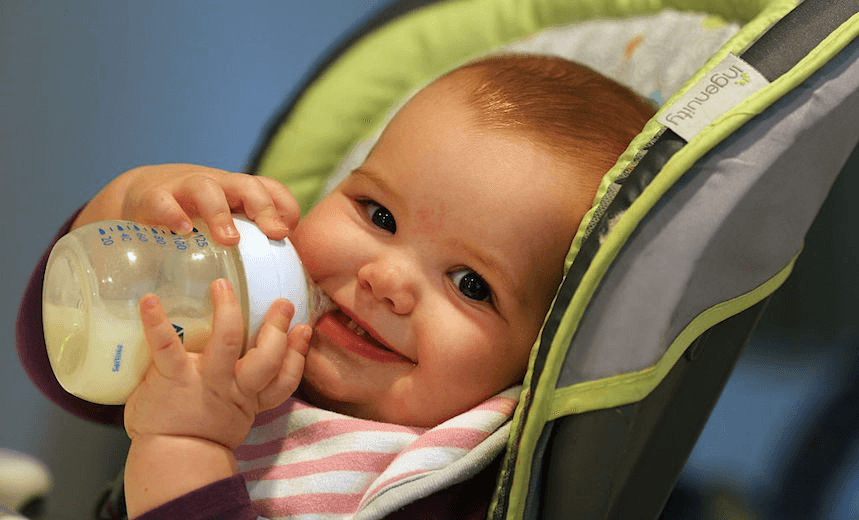We all know that breast is best, but is it fair that mothers who are forced (or choose) to bottle feed are forever made to feel second best? Maryrose Painter wonders why there is so little help and information available to mums who hit the bottle.
Before I gave birth to my daughter earlier this year, I prepared myself for a breastfeeding battle. I had an honest conversation with my midwife, bought bottles and a steriliser, talked at length with my husband. I planned to give breastfeeding my best shot, but I also knew I might not be able to produce enough milk.
I had breast reduction surgery a couple of years ago. My surgeon warned me I might struggle to breastfeed and wasn’t able to predict how much milk I’d have. Some women have plenty of milk in spite of the surgery, others find they produce no milk at all. As I was suffering intractable back pain at the time, taking a gamble on breastfeeding children I did not yet have seemed reasonable.
Squishy was born with a healthy appetite. As per my midwife’s advice, I put her to the breast moments after birth. She had a good latch and a strong suck, but I couldn’t feel anything coming out of my breast.
Squishy and I worked hard to get my milk flowing those three days in hospital. I let her suckle as long as she wanted, then I would pump afterwards. My nipples cracked and bled. The pump’s collection container stayed empty. Squishy wasn’t getting enough to satisfy her, so the nurses helped me to top her up with formula. Feed, pump, bottle, nappy, sleep, repeat. “When your milk comes in it’ll be like Niagara Falls!” my mother encouraged me.
It wasn’t.
A pathetic dribble of milk finally came on day four. Squishy still wasn’t getting enough to eat – 20 minutes at each breast didn’t dent her appetite in the slightest. Combining breast and bottle made each feed intolerably long, especially in the middle of the night. I was exhausted, and Squishy was getting frustrated with my underperforming dairy factory. We saw the hospital’s lactation consultant, who made suggestions about how to increase my milk production, but she couldn’t tell me whether I’d ever have enough milk. No-one could.
When Squishy was two weeks old, and the dark circles under my eyes were the colour of thunderclouds, and I was still answering the door in a spill-covered dressing gown, my midwife got down to brass tacks. “You’re doing all the right things, but if the tissue isn’t there, you might not be able to produce more milk. Do you want to keep going?”
I burst into tears and told her I just couldn’t.
From that day on, my daughter has been exclusively formula fed. According to Plunket, over 80% of babies are at least partially breastfed by their six week check-up. This is great news, because we know breast milk benefits babies. The Ministry of Health’s baby friendly initiative has demonstrably lifted breastfeeding rates, and that’s great.
But breastfeeding is not always possible, for all sorts of very good reasons. And for mums that can’t, or choose not to, there’s a big lack of support and information available. That’s a problem.
All the things that would have been really useful to be told – like which brand of formula to feed, how much milk and how often, which bottle to use, and how to tell if a different teat is required – I had to pick up piecemeal. I Googled, quizzed shop assistants and called Plunketline endlessly. These fact-finding missions were often tearful.
At three weeks, Squishy began to spit up her entire bottle after most feeds. Soaking wet with half-digested formula and my own tears, I called Plunket. The kindly nurse who answered the phone asked how much I was feeding Squishy and how often. It turned out I was overfeeding, and that baby’s tiny tummy couldn’t hold the volume of milk I was trying to put in it. I felt horrible. I had no idea it was possible to overfeed a baby.
At four weeks, Squishy started to get uncomfortable with wind. She pulled her knees into her tummy and howled after feeding. I tried desperately to get all her burps up, without success. Plunket suggested I try a different brand of bottle, but the nurse explained she wasn’t allowed to recommend any. I left Squishy with my husband and went to the baby shop. The wonderful lady behind the counter gave me a full rundown on vented and unvented bottles, wide neck and narrow neck teats. She asked all about my daughter’s feeding habits and whether she had a tongue tie. I bought the bottle she suggested and we’ve been using it with great success ever since.
At six weeks, my doctor’s nurse mentioned in passing it was good to roll the formula can on the bench to unsettle the heavier particles from the bottom, where they’d likely have settled in transit. News to me.
Squishy is now five months old. She’s doing well. I’m doing well. But it would have been easier to get here if someone had handed me a ‘formula-feeding basics’ booklet, or referred me to a bottle-feeding support group. As far as I know, these things don’t exist. But they should. We gain nothing as a society by pretending bottle feeding isn’t happening.
I’d like to see good information and support provided to formula-feeding Mums so we can feel nurtured, empowered and included. We deserve it – we’re doing the best we can for our babies, just like everyone else.
MaryRose Painter is a Wellington-based communications advisor and a proud mum of one. She likes Open Source software and correct grammar, and she’s on Twitter at @dickens_chicken.
